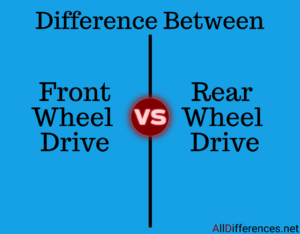Comparison Front Wheel Drive and Rear Wheel Drive On A Vehicle
Difference Between Front Wheel Drive and Rear Wheel Drive

Comparison Chart
| Front Wheel Drive | Rear Wheel Drive |
|---|---|
| Weight in front of the vehicle is much Greater than rear due to engine, steering, final drive are at the front. So the weight of the vehicle may not balanced. | Rear wheel drive Weight of the vehicle is well balanced on all wheel due to the engine at the front and final assembly at rear. |
| This layout provides a low floor since there is no longer propeller shaft and drive (differential) is placed at the front instead of the rear. | It required long propeller shaft and differential at the rear. Hence, floor height is Greer than front wheel drive. |
| The clutch, gearbox, and differential are usually made as one unit thereby cost are reduced. | The clutch and gearbox at the front and fin ve at the rear, are not a single unit, hence the cost is increased. |
| Due to the more weight placed on the wing wheels, the vehicle has more adhesion on road. | Due to less weight on driving wheel, there is a chance of skidding on slippery surfaces. |
| Due to good adhesion on road, good the capacity even on the curves. | Due to less adhesion on road, less holding capacity |
| Luggage space at the rear is spacious. | Luggage space is available at the rear but due to final drive at back, it is less spacious. |
| On a gradient or while accelerating, the weight of vehicle shifts (due to inertia) to the rear wheels it is not desirable for better adhesion. Hence, a tractive effort is reduced on a gradient. | On a gradient or white accelerating, the weight of vehicle shifts to the rear wheel which is driving wheels, hence, at that condition better adhesion and tractive effort available. |
| On slippery gradients, understeer condition develop which is not desirable. | On slippery gradients, there is very less Ounce of understeer. |
